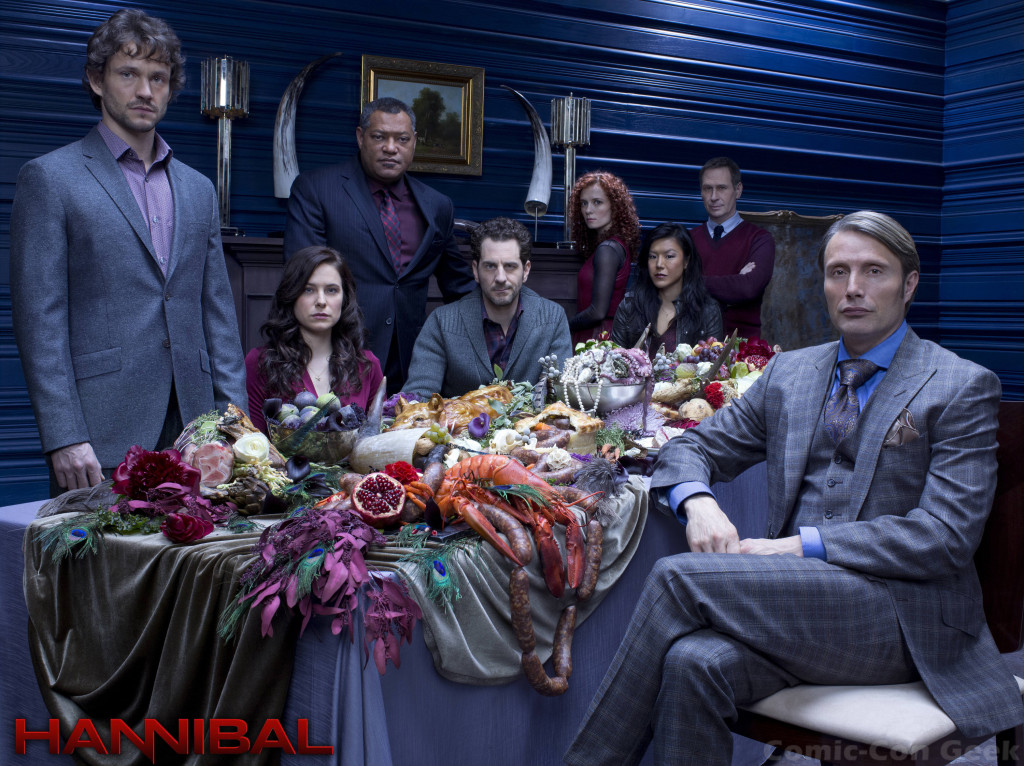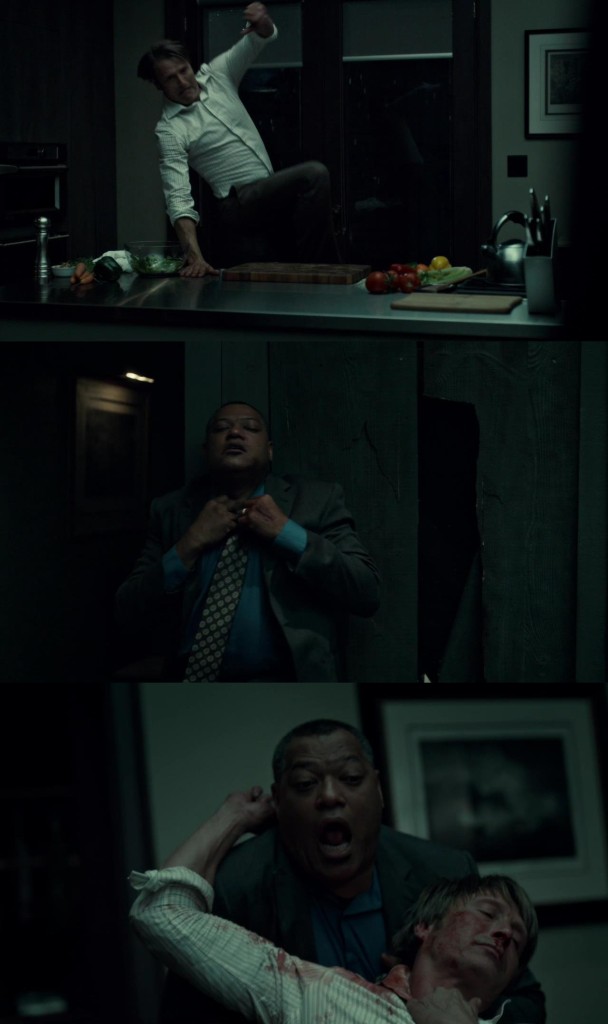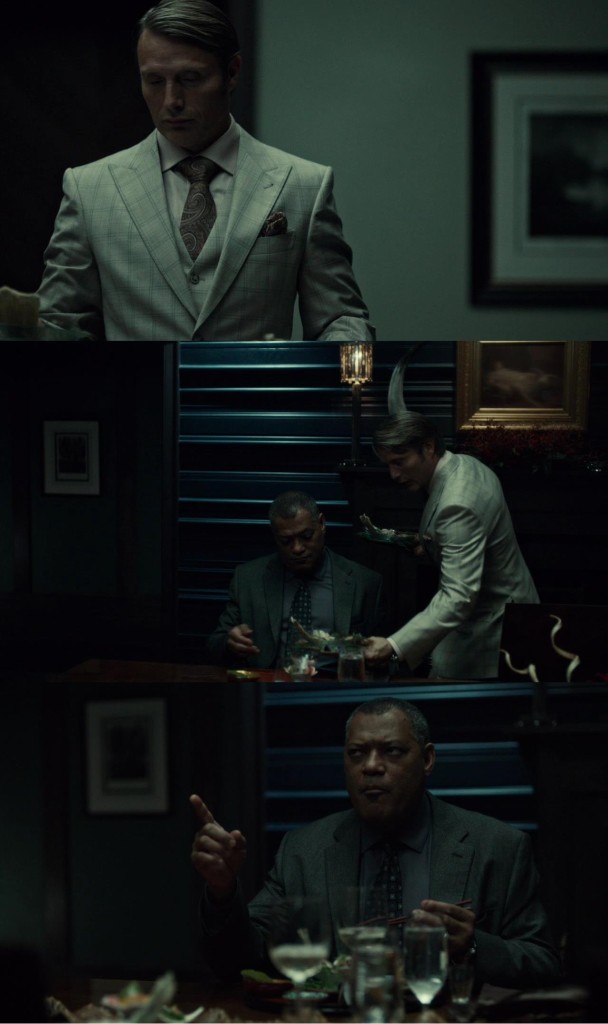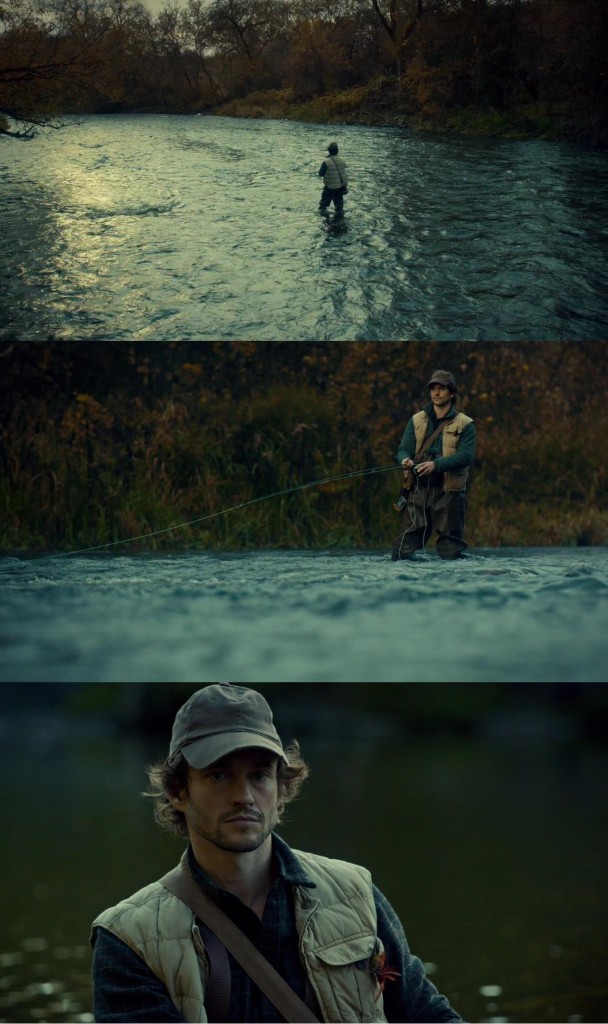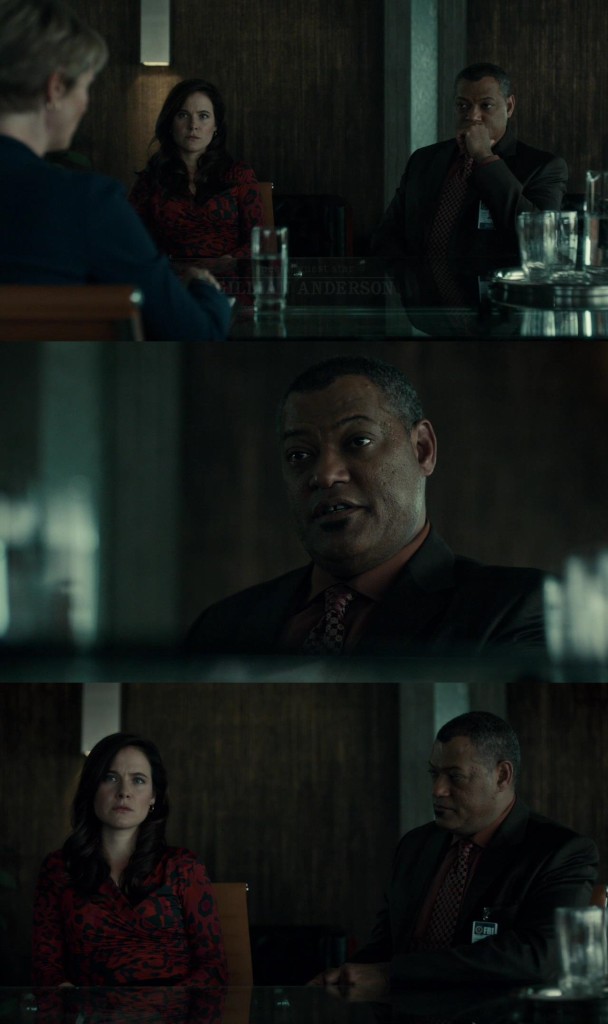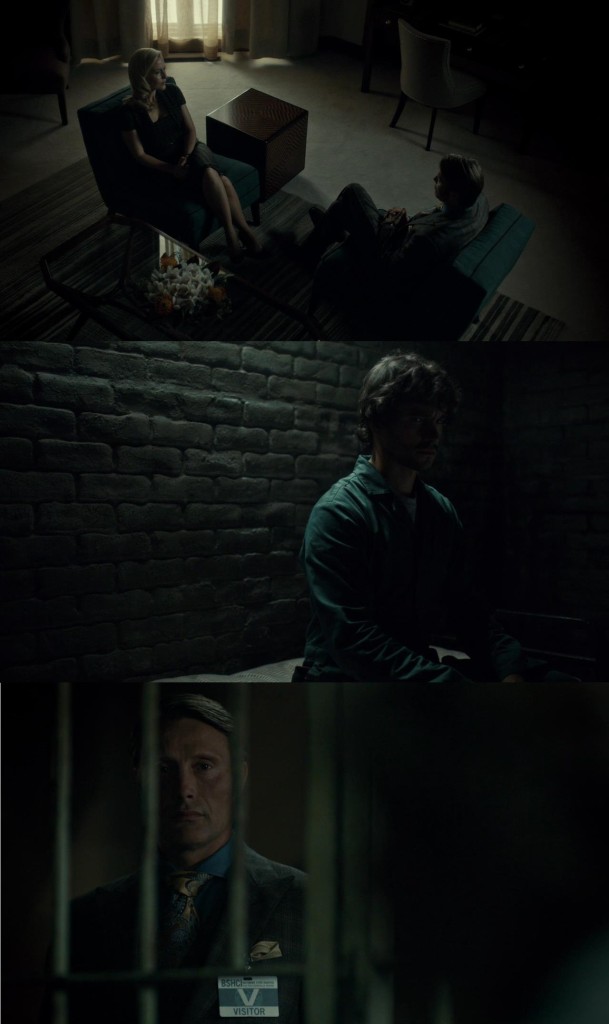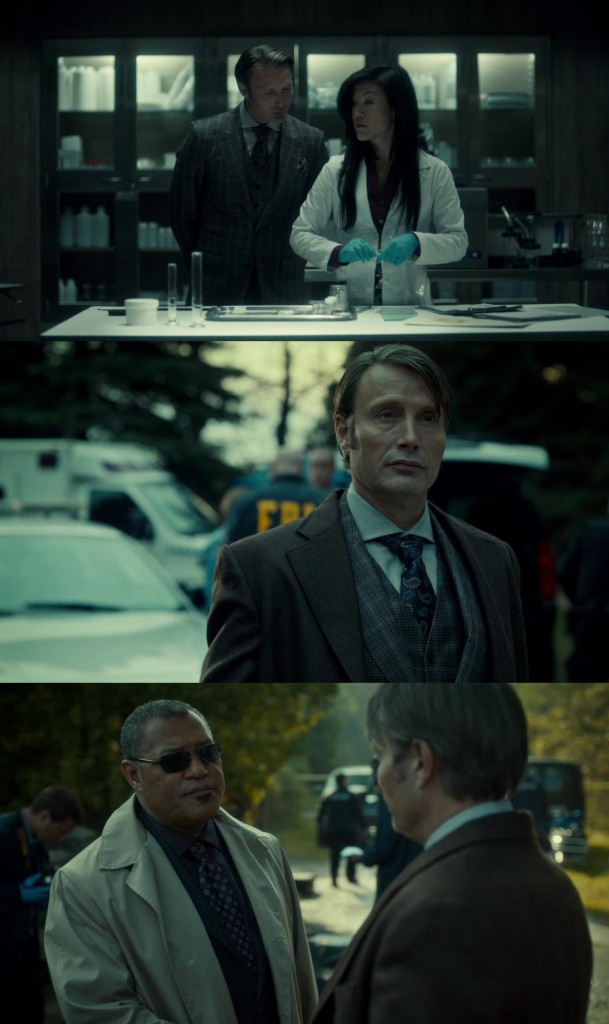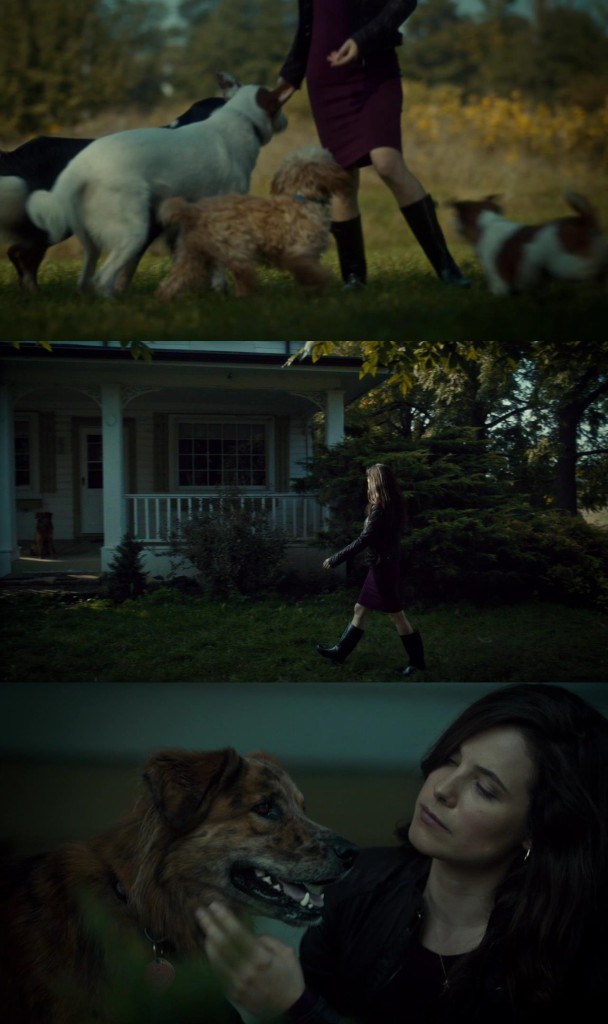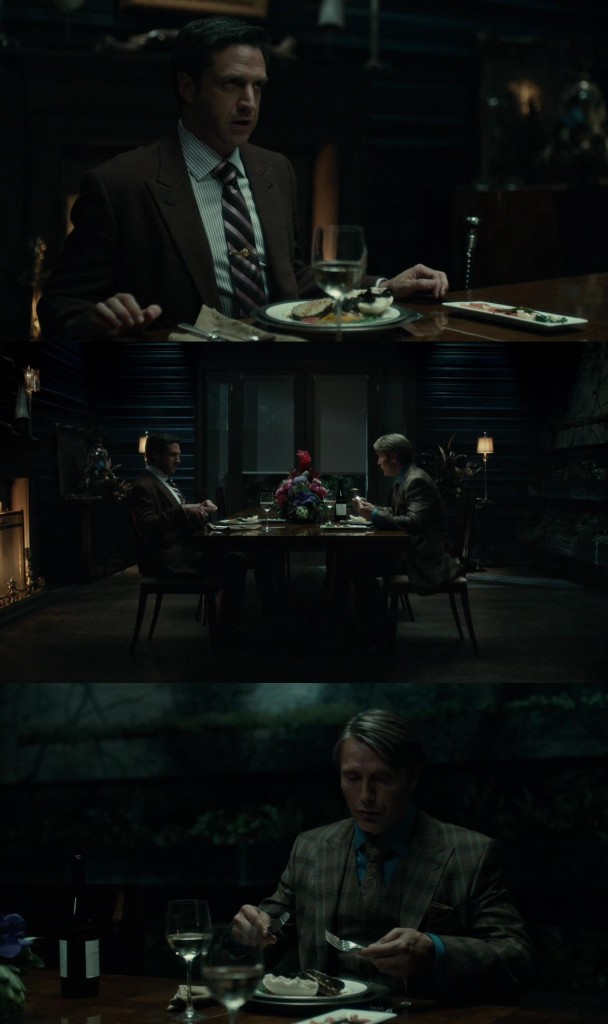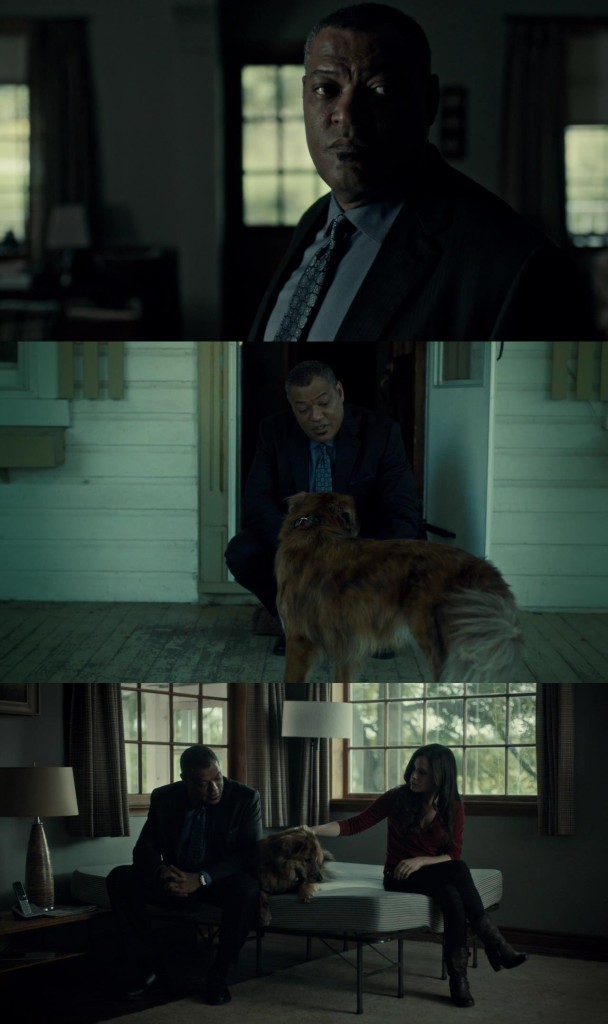WARNING SPOILERS AHEAD!
Hannibal is a show with amazing aesthetics that not only look enthralling , but also serve to give insight into the personalities and hidden desires of the characters. Most television shows put costumes on their characters by simply choosing something that will look good, not bothering to use costumes to enhance the show’s storytelling. There are a select few costume designers who are working at such a level, namely Janie Bryant, who has designed for Deadwood and Mad Men, among many other shows. Christopher Hargadon, the costume designer for Hannibal, is the latest to join this rank. Taking a look at the first episode of the second season offers a prime examples of this once the meaning and usage of the costumes is deconstructed.
The first scene of the new season is a brutal fight between Hannibal Lector (Mads Mikkelsen) and Jack Crawford (Laurence Fishburne); a shocking and unexpected opening that leaps far down the narrative road within the series. But if we look beyond the action sequence, we can look into the minds of the characters (and pretend that we’re just like Hannibal! In that we will have psychological insight… no eating people…). In this scene, Hannibal is wearing a simple white striped shirt. This is a stark change from the bright jackets and ties that were his common look in the first season. He is in his kitchen, probably the room where he feels the most comfortable being himself (which is unsettling). He is not expecting anyone and is therefore dressed down. White is usually used to show youth and innocence. But in this scene, where we see Jack’s (eventual) knowledge of his crimes come to a climax, any semblance of innocence or tranquility comes crashing down around him. His white shirt becomes covered in blood, blotting out (forever?) the facade of guiltless detachment Hannibal has carefully cultivated.
Jack Crawford enters wearing blue tones. Blue is a sign of stability and, not coincidentally, is also the color most associated with law enforcement. Jack goes to the house with the intention of confronting Hannibal with the accusation of his terrible crimes and chooses a color that backs up the power that he has as a FBI agent finally in the know. Unlike his opponent, Jack is also holding onto previous patterns, as seen in his tie. Jack’s ties are always a series of complex geometric patterns. These regular patterns show organization and a wish to put order to the universe. Jack’s job is to catch monstrous serial killers, perhaps the best personification of chaotic evil, and we see this in pretty much every single tie he wears.
The episode then jumps to months earlier, when Jack has no suspicion of Hannibal, and they sit down to dine as colleagues. Here we see Hannibal dressed in his usual look: plaid suit with a paisley tie. He is serving a meal at home, where he feels comfortable to show off. Hannibal, consummate psychopath that he is, is putting on his peacocking and charming persona for his guest, in contrast to the plain shirt he was wearing previously. Hannibal’s choice in tie design is also a fascinating one. Paisley designs have a long history, and is notably used as a symbol for the harvest in some Indian traditions. When the symbol was seen in agricultural communities, people knew that the fields were ready to harvest and the farmers needed assistance. By wearing paisley ties Hannibal is subtly announcing that he is always ready for the “harvest,” which takes on a sickening meaning since the viewers know that he consumes his victims. Additionally, paisley designs are reminiscent of leeches, which attach themselves to something and slowly suck out their blood. Hannibal has attached himself to Will Graham (Hugh Dancy), the series’ protagonist, and instead of just killing him, he is slowly pulling him down. Anyway, back to the scene at hand. Even though Jack does not suspect Hannibal of anything at this time, there is still a disconnect between the two characters. They are not dressed in similar colors, styles, or patterns. They come from two very different worlds and mindsets, and while they can share a meal together, they will never me on the same page. Also, we see the same geometric design on Jack’s tie! Hooray for motifs!
The episode then shows a dream of the institutionalized Will Graham’s in which he is fishing, which we’ve seen before. The earth tones connect him to nature and his life before working for the FBI, which lead to his dramatic mental deterioration in season one. He wears a green shirt, which is not a color we see very much in the costume design of Hannibal. This usage of the color green shows balance, harmony and perhaps even sanctuary. This dream state is his escape from everything that is currently happening in his life. We then see him in close up as he notices something in the distance and the shirt has changed to a blue plaid. His harmony is broken because in the distance he sees the stag, an animal tied to one of the killers from season one that has been haunting his dreams and visions. It is interesting to note that in dreams, plaid signifies being torn between two sides of yourself, usually a conservative side that follows societal rules and a more liberal side that ignores them. We often see Will and Hannibal wearing plaids. This feels a bit too simple for the show, but it still a recurring theme throughout its run, seen in both the narrative content and the physical patterns. The show also uses an oversaturation of blue to create an unease in the viewer. In small amounts the color is calming and strong, but when used everywhere it overwhelms and unsettles people.
In another scene we see Jack and Alana Bloom (Caroline Dhavernas), a consultant psychologist with the FBI who has a past emotional and romantic attachment to Will. They are sitting in an office together, being questioned about the mental state of Will Graham and whether he could be a serial killer, as the evidence Hannibal manipulated seems to point to. Jack and Alana are dressed in similar colors, showing that they are on the same page when it comes to wanting the best for Will. We can see, however, that they have different beliefs about his level of guilt. Alana, as usual, is in a patterned dress, animal print this time, that shows how conflicted her thoughts and feelings are. She does know how to sort out her trust and affection towards Will with the evidence that the FBI has against him. By contrast, check out Jack’s tie! Geometric patterns again. (Woo motifs!) Alana’s animal pattern dress is more chaotic. She does not see the world along strict lines like Jack does, but with more fluidity and greater potential for chaos. Also, does Jack only own one suit? He seems to be wearing the same one we’ve seen previously here. Hannibal is in a differently colored plaid suit each time we see him, but Jack is always in the same black suit each time we see him. Either he only has one, or he has a closet full of the same style.
Later in the episode we see another of Hannibal’s psychiatric sessions with his shrink, Dr. Bedelia Du Maurier (Gillian Anderson). The two characters here are dressed very similarly. They look to be wearing nearly the same color and both have small patterns on their outfits. It seems like the show is conveying that Hannibal’s choice of wardrobe is very specific when he attends these sessions. He is attempting to create a connection with his psychiatrist. Though in the next scene we see how much he does not fit in. He goes to see Will in the asylum and his outfit stands out starkly, especially compared to Will, who practically blends right into the background. We do not see much of Will in this episode, but when we do he mostly disappears into the shot. Despite being the driving force for much of the content in the first episode, he feels that he has been forgotten while in prison and accordingly is dressed like he is fading out of existence. By contrast, Hannibal, who is the actual monster in this scene and will eventually be held in one of these cells, stands out dramatically. He looks overly formal, especially with that bright yellow tie he has on. The color yellow is often thought of as a bright cheery color, though it can also be read as untrustworthy and destabilizing.
In the next few scenes we see Hannibal interacting with members of the FBI team. He is putting on a public persona in order to fit in, acting helpful in order to draw away any suspicion.. He and Beverly Katz (Hettienne Park), an FBI Special Agent, match each other with his purple tie and her purple shirt. Her white jacket can also be read as showing innocence, not knowing (or even suspecting) who she is standing with. We then see him at a crime scene where he again matches Jack’s purple tie. We see purple a lot in this show, especially on Jack, and it often used to show wisdom and dignity. Someone who wants to portray themselves as a leader would wear the royal purple, though the dark tones that Jack wears also evoke the gloom that surrounds his job.
We also get a glimpse of Alana on her own, away from the FBI. She is taking care of Will’s dogs while he is incarcerated and shows great comfort with them, away from the stresses of the FBI. Here we see her in a plain dress, symbolically resolving the conflict as she showed earlier in the episode. She knows what side she is on now. We also see her wearing a lot of red tones in this episode, signifying her desire towards Will. In her last scene, she was torn between two sides wearing a red and black dress, while here she is only wearing maroon. Things are much clearer for her away from the presumption of Will’s guilt at the FBI.
Hannibal is shown again hosting another guest for a sumptuous dinner. He is wearing brown tones, which show reliability and approachability. He wants to look as stable as possible around Dr. Frederick Chilton (Raúl Esparza), who runs the Baltimore State Hospital for the Criminally Insane that is housing Will. Hannibal looks completely comfortable in his own home and even though the dining room is busy and colorful Hannibal does not look out of place. This is in stark contrast to Chilton, who wears a very traditional outfit with a striped tie, showing him as a harmless man. Stripes show a desire to follow the rules and not deviate from the norm. He sees instability every day in his work, so he exudes calm and control in his outfit choices.
Lastly we see Alana and Jack encountering each other at Will’s home. Alana is again in plain colors, not the busy patterned dresses we usually see her in at work. She was not expecting to see Jack, and thus was not demonstrating her uncertainty. The deep red in her shirt is linked to confidence and her emotional connection to Will. Jack is in his usual geometric tie and his stable blue color. Even here, in a safe and domestic setting, the two characters are disconnected from one another, not wearing similar colors or patterns.
These examples, from just one episode, of the costuming on Hannibal show how it goes above and beyond the work of most other TV shows on the air today. The choices in pattern and color directly comment or indicate the characters’ wants and moods. It’s so well-planned and executed that careful observation of the costumes can let the viewer predict what turns the show may take in the future. In conjunction with the series’ peerless cinematography and mise-en-scene, the costuming makes Hannibal one of the deepest and most rewarding aesthetic experiences on the air.

